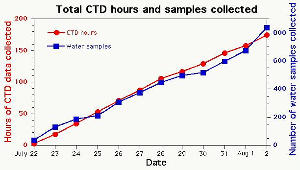| |
Science
Report:
The last
data have been collected, the last sample analyzed, and the maps stowed
away. We have spent 14 days at sea, recorded almost 200 hours of CTD data,
and collected almost 900 water samples. We have worked every day, sometimes
around the clock, and gotten to know our shipmates a little bit better
in the process. And we have improved our knowledge about the seafloor
hydrothermal systems along the Juan de Fuca Ridge. All in all it has been
a successful and enjoyable cruise. All that's left today is trying to
figure out which piece of equipment goes in which box-and this is sometimes
more difficult than the science work.
We have learned that our
hypotheses about the evolution of the hydrothermal fields created by the
1998 lava eruption on Axial Volcano are substantially correct. Venting
activity, so vigorous immediately after the eruption, decreases quickly
at first and then more slowly with time. Combing our new data with those
collected over the last two years will enable us to construct a mathematical
model of this cooling off process.
We have also learned that
the hydrothermal systems on the Cleft segment of the Juan de Fuca Ridge
are still going strong some 16 years after their discovery. These systems
must be heated by a much larger magma source than other systems that cool
in a few years after an eruption. There are still a lot of mysteries in
the deep, enough for a lot of new scientists for many years to come.
My thanks for making this
cruise so successful go to the many people you've been reading about here
over the last two weeks. PMEL scientists Joe Resing, Sharon Walker, Geoff
Lebon, Ron Greene, and Dana Greeley performed their usual professional
jobs. We also had help from Rachel Shackelford, a graduate student at
the University of Hawaii, Dan Sadler, a research technician also from
Hawaii, and two college students: Peter McAuliffe from Carleton College
and Kate Grof Tisza from the US Naval Academy. The distribution of all
this information over the web would not have been possible without the
daily efforts of our two Teachers-At-Sea, Carol McDowell and Mary Beth
Sands. And of course without the capable seamanship of Capt. Parsons and
the crew of the Ronald H. Brown we could have accomplished nothing.
I hope you've enjoyed this
brief look into oceanography at sea. For me, nothing is quite as exciting
as new discoveries, except perhaps telling the rest of the world about
them.
Ed Baker Chief Scientist, VENTS Leg 3
|
|

Final plot of CTD hours and number of water samples complete on NeMO-CTD
cruise.
(click for full-size)
|
|

